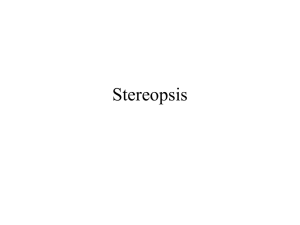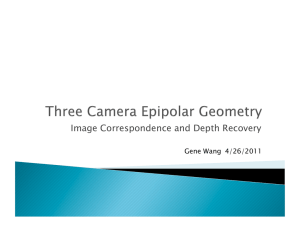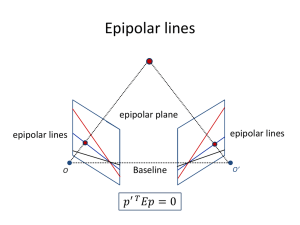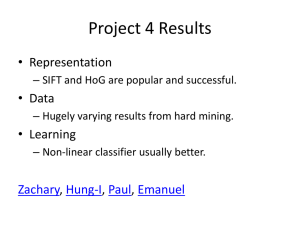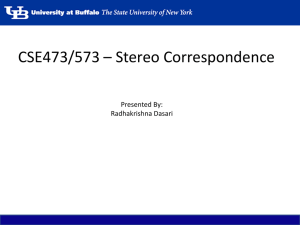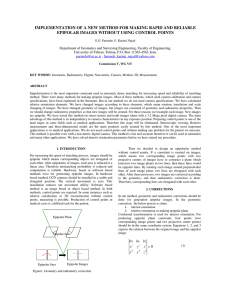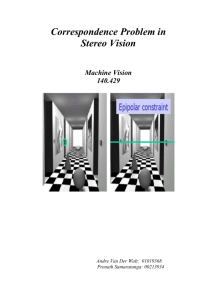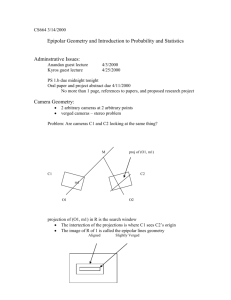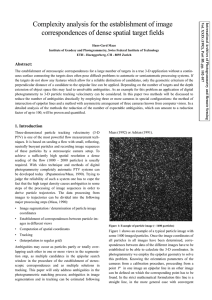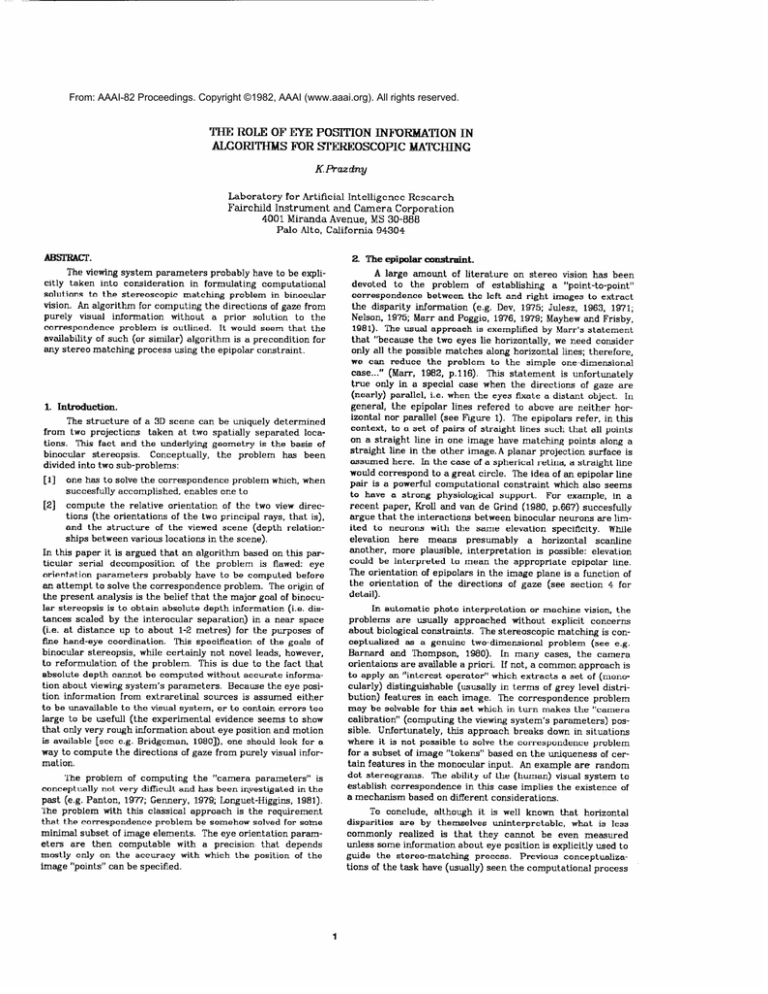
From: AAAI-82 Proceedings. Copyright ©1982, AAAI (www.aaai.org). All rights reserved.
THE ROLE OF EXE POSITION INFORMATION IN
ALGORITHMS FOR SJXREOSCOPIC MATCHING
KFrazdny
Laboratory for Artificial Intelligence Research
Fairchild Instrument and Camera Corporation
4001 Miranda Avenue, MS 30-886
Palo Alto, California 94304
AE3srR4cr.
2
The viewing system parameters probably have to be explicitly taken into consideration
in formulating
computational
solutions to the stereoscopic
matching problem in binocular
vision. An algorithm for computing the directions of gaze from
purely visual information
without a prior solution to the
correspondence
problem is outlined.
It would seem that the
availability of such (or similar) algorithm is a precondition for
any stereo matching process using the epipolar constraint.
1.Introduction.
The structure of a 3D scene can be uniquely determined
from two projections
taken at two spatially separated locations. This fact and the underlying geometry
is the basis of
binocular
stereopsis.
Conceptually,
the problem
has been
divided into two sub-problems:
[II
one has to solve the correspondence
problem
succesfully accomplished, enables one to
121
compute the relative orientation
tions (the orientations of the two
and the structure
of the viewed
ships between various locations in
which, when
of the two view direcprincipal rays, that is),
scene (depth relationthe scene).
In this paper it is argued that an algorithm based on this particular serial decomposition
of the problem
is flawed; eye
orientation parameters
probably have to be computed before
an attempt to solve the correspondence
problem. The origin of
the present analysis is the belief that the major goal of binocular stereopsis is to obtain absolute depth information (i.e. distances scaled by the interocular
separation)
in a near space
(i.e. at distance up to about 1-2 metres) for the purposes of
fine hand-eye coordination.
This specification
of the goals of
binocular stereopsis, while certainly not novel leads, however,
This is due to the fact that
to reformulation
of the problem.
absolute depth cannot be computed without accurate information about viewing system’s parameters.
Because the eye position information
from extraretinal
sources is assumed either
to be unavailable to the visual system, or to contain errors too
large to be useful1 (the experimental
evidence seems to show
that only very rough information about eye position and motion
is available [see e.g. Bridgeman,
1980]), one should look for a
way to compute the directions of gaze from purely visual information.
The problem of computing
the “camera parameters”
is
conceptually not very difficult and has been investigated in the
past (e.g. Panton, 1977; Gennery, 1979; Longuet-Higgins,
1981).
The problem with this classical approach is the requirement
that the correspondence
problem be somehow solved for some
minimal subset of image elements.
The eye orientation parameters are then computable
with a precision
that depends
mostly only on the accuracy with which the position of the
image “points” can be specified.
The epipohr
axmtraint.
A large amount of literature
on stereo vision has been
devoted
to the problem
of establishing
a “point-to-point”
correspondence
between the left and right images to extract
the disparity information
(e.g. Dev, 1975; Julesz, 1963, 1971;
Nelson, 1975; Marr and Poggio, 1976, 1979; Mayhew and Frisby,
1981). The usual approaeh is exemplified by Mar& statement
that “because the two eyes lie horizontally,
we need consider
only all the possible matches along horizontal lines; therefore,
we can reduce the problem
to the simple one-dimensional
case...” (Mar-r, 1982, p.116). This statement
is unfortunately
true only in a special case when the directions of gaze are
(nearly) parallel, i.e. when the eyes fixate a distant object. In
general, the epipolar lines refered to above are neither horizontal nor parallel (see Figure 1). The epipolars refer, in this
context, to a set of pairs of straight lines such that all points
on a straight line in one image have matching points along a
straight line in the other image.A planar projection surface is
assumed here. In the case of a spherical retina, a straight line
would correspond to a great circle. The idea of an epipolar line
pair is a powerful computational
constraint which also seems
to have a strong physiological
support.
For example,
in a
recent paper, Kroll and van de Grind (1980, p-667) succesfully
argue that the interactions between binocular neurons are limited to neurons with the same elevation
specificity.
While
elevation
here
means
presumably
a horizontal
scanline
another, more plausible, interpretation
is possible: elevation
could be interpreted
to mean the appropriate
epipolar line.
The orientation of epipolars in the image plane is a function of
the orientation
of the directions
of gaze (see section 4 for
detail).
In automatic photo interpretation
or machine vision, the
problems
are usually approached
without explicit concerns
about biological constraints.
The stereoscopic
matching is conceptualized
as a genuine two-dimensional
problem
(see e.g.
Barnard and Thompson, 1980). In many cases, the camera
orientaions are available a priori. If not, a common approach is
to apply an “interest operator” which extracts a set of (monocularly) distinguishable
(ususally in terms of grey level distribution) features in each image. The correspondence
problem
may be solvable for this set which in turn makes the “camera
calibration” (computing the viewing system’s parameters)
possible. Unfortunately,
this approach breaks down in situations
where it is not possible to solve the correspondence
problem
for a subset of image “tokens” based on the uniqueness of certain features in the monocular input. An example are random
dot stereograms.
The ability of the (human) visual system to
establish correspondence
in this case implies the existence of
a mechanism based on different considerations.
To conclude, although it is well known that horizontal
disparities
are by themselves
uninterpretable,
what is less
commonly
realized
is that they cannot be even measured
unless some information about eye position is explicitly used to
guide the stereo-matching
process.
Previous conceptualizations of the task have (usually) seen the computational process
as decomposeable
into two serial modules: first extract the
This cannot work
and then interpret
them.
disparities,
because in order to solve the correspondence
problem utilizing
the epipolar constraint one needs accurate information
about
cannot be obtained
the direction of gaze. This information
from extraretinal
sources and has to be computed from visual
information.
Rut in order to do this one is supposed to have
solved the correspondence
problem for some minimal subset of
Image feature points. This is the famous “chicken and egg”
problem ln another disguise. It is interesting to note that the
problems of this class arise frequently in the investigation of
visual perception.
For example, the computation
of “shapefrom-shading” and obtaining the direction of illumination seem
to be similarly interrelated.
3. Pcrssiblesohdions.
Three solutions to the problem
themselves immediately.
identified
above
present
L13 One
can eliminate the epipolar constraint completely and
conceptualize
the stereoscopic
matching in a way similar
to motion computation
in monocular
motion parallax
situation,
i.e. as a genuine two-dimensional
matching
problem (see e.g. Barnard and Thompson, 1980).
PI
One may try to develop a scheme in which it is possible to
make the stereoscopic
matching and the computation of
directions
of gaze run concurrently
as an intrinsically
cooperative
process. One way to do this may be to make
the matching process a function of the eye orientation.
L31 The third possibility
is to compute the eye orientation
angles prior, and independently of, the subsequent matching process which may then use the epipolar constraint.
at least,
In section 5 it will be shown that it is, theoretically
possible that an algorithm of this latter class, directed by the
global requirement
that the directions of the gaze of the two
eyes must be the same which ever points are used to compute
them (this is a very strong global constraint holding over the
whole image) could be used to accomplish this. The computational complexity of the proposed algorithm can be enormous if
the minimal subset of feature point pairs (potential matches)
needed to compute candidate
directions of gaze is large. In
the next section it will be shown that when some simple
assumptions are made, this subset can be as small as 2 or 3
feature points. It will be seen that under these circumstances,
the whoie process can usefully be conceptualized
as maintaining a l-dimensional histogram and locating its highest peak.
4 computing the airections of gaze
Refer to Figure 2. It is assumed that the eye moves in
such a fashion that the results of its motions can be described
by a rotation utilizing only two of the possible three degrees of
freedom (Donder’s law). In our case, the description consists of
rotations about an axis perpendicular
to a common plane which
itself is restricted to rotations about the interocular axis (vector p in Figure 2).
An image point pi and the interocular
distance Q Or
define a plane which cuts each image along an epipolar line. In
the case- of a planar projection surface, these two lines are
straight lines. All epipolars in an image meet at one common
point. The locus of zero “vertical” disparities coincides (in our
case) with the image x-axis. Refering to Figure 2 it is easy to
see that
(the focal distances are assumed to be 1). After some algebra
it is seen that the x-coordinates
of the epipolar intersections
are specified by (ta@,O)
and (tan(a+@),O)
in the left and right
image coordinate
frames respectively
(the y-coordinates
are
zero).
Within this geometry, the eye orientation parameters
(the
angles a and 8) are computable
from the correspondences
defined at three (the fovea and two arbitrarily
choosen) image
points, and solving a single fourth-degree equation. To see this,
consider a (left) image point p’i, with a corresponding
point in
The transformation
from the right to the
the right image p”i.
left image coordinate system is define simply as
Pi’fii’=(Pi”&ff+T)A
A [co%(a) 7 sh$a)
=
0 cos (a)
I-sin(a)
Ps’~~‘A-‘=(Pj”Pi”+it’)
(24
Multiplying equation (2a) by the unit vector pi” (vector
duct is denoted by a “xl’), and scalar multiplying (denoted
“.“) the result by ? produces
proby a
Pt’(Pi’A-’
% = (1,W)
jr = jL = (0.1.0)
X
Pi”)
. “?=O
@b)
This means that (?i’A-’
x Pi “) is perpendicular
to ?. Conseproduct
vector
the
quentl ,
’ x Pi “) points in the direction
Fj=$i’A-’
J
X Pi”)
X ($,‘Ai.e.
e same
must hold for any pair of points,
ni =(Pj’A-’
X Pj “) X (&‘A-’
X &“).
Thus
Klij X njk
=O
(3)
It is advantageous to chose point pi to be the fixation point, i.e.
#i’
and $iil’=(O,O, 1). [It is assumed that the principal
-=(O,O,l)
.
rays through the two centres of fovea do indeed intersect.]
Expanding (3). and after a good deal of algebra, we obtain
rxc4+bz3+cz2+dz
where
x=&%(a),
;zM$&$.
+e =0
and a, b, c, d, and e are
(4)
some
constant
xT$is, is(ob;;(~;o~‘$~={sin(a),O,cos
(a))
so
.,I.
.
ua ion (4) has a closed
form Glution an: four distinct’ roots, in general. An important
point to note is the fact that equation (3) does not involve
radial distances, and that it holds for all points on the epipolar
line (i.e. if equation (4) applied to points j and k results in a
value x, the same value x is obtained using points j and 1 provided k and 1 lie on an epipolar line in the right image).
To compute the eye orientation angles (and thus the slope
of the epipolar lines on the image surface) one may use the
enormous amount of redundancy afforded by the global constraint that the directions of gaze have to be the same whatever set of points is used to compute them. The following simple algorithm accomplishes this.
[l]
For each pair of points p’i ,p> in the left image, consider
all possible matches (within some neighbourhood)
in the
right image, and for each such possibility, compute the
value sin. (a) as outlined above [equations (3) and (4)].
[2]
Make a histogram of those values of &(a)
lying within
the allowable range (e.g. the principal directions cannot
point behind the head, nor even too much sideways). If a
= (-sina,O.cosa)
@L = (Os41)
9!$ = (cosa.O,sina)
I
Equation (1) can also be written as
7, =(sin&O,cosfI)
$
(1)
This says that the vector Pi ‘=Pi ‘Pi’ (Pi’ is the magnitude and
pi’ is th e unit direction vector) defined in the left coordinate
system, is abtained from its counterpart,
defined in the right
coordinate system, by translating and rotating it respectively.
T=I? where I is the interocular separation.
The rotation A is
determined by the matrix
Ac~edgement..
particular value of Sin(ol) occurs n-times, the histogram
value till be n. In practice, because of errors of various
nature, one would update the frequencies
within some
neighbourhood
of-a particular value of sin (a) (according
to some, perhaps gaussian, weighting function).
I wish to thank Prof. John Mayhew and Dr. J.M.Tenenbaum
for their comments and discussion.
Chose the value under the highest peak of the histogram
as the true value of sin(a).
compute the angle /3 (from
2b), and from this the orientation of the epipolar lines.
Barnard ST. Thompson
W.B. 1980
Disparity analysis of images
IEEE nuns. Pat.An. Much.Intell. 4, 333-340
It is clear that because of the more or less random nature of
the competing “incorrect”
matches (i.e. matches not lying on
the correct
epipolar lines), the histogram
will indeed peak
above the correct value of sin (a).
Bridgeman B. 1980
Direct perception and a call for primary perception
The Brain and Behavioral Sciences, 3, 382-383
Dev P. 1975
Perception
of depth surfaces in random-dot
Int. J. Mun Mach. Studies 7, 511-528
The method, in its present form, has several shortcomings. One is its “pointilistic” way of treating the images. The
assumption that an image can usefully be described by point
descriptors is valid in the case of a random dot stereogram but
may not be very useful in the general case.
stereograms
Gennery D.B. 1979
Object detection and measurement
using stereo vision
Proceedings DARPA Image Understanding Workshop 101-107
Science Applications Inc.
Arlington, Virginia
The second problem is exemplified by the disparity field in
Figure 1. While the disparities associated with elements of the
frontal surface are within the fusable range specified by the
Panum’s area, the disparities associated with the background
surface are clearly
too large (this is why the vergence
eye
movements are essential to fusion). Consequently, if the image
as a whole writes into the same histogram,
and there are
regions with disparities larger than the testing neighbourhood
used in step [l], one may encouter problems.
One solution
may be to keep local histograms and test for agreement.
This
in turn suggests an intriguing possibility of segmenting
the
image on the basis of binocular combination before any depth
perception.
[This problem may turn out to be a non-problem in
view of some evidence suggesting that binocular interactions
can occur between points separated by as much as 7 degrees of
visual arc (see Marr, 1982, p. 154).]
Julesz B. 1963
Towards the automation of binocular depth perception
Proceedings IFIPS Congr., Munich P962
ed.C.M.Popplewel
Amsterdam:
North Holland
Julesz B. 1971
Foundations of Cyclopean Perception
Chicago: The Uniyersity of Chicago Press
fioll J.D. Grind W.A. van de
The double-nail illusion
Perception 9, 651-669
The proposed algorithm is local and parallel in nature: the
computation
of a, and the histogram updating can easily be
done at each image locus at the same time and independently
of computations
at other retinal
loci.
It should also be
observed that nothing has been said about the classic ambiguity problem; it is orthogonal, in a sense, to the question of
‘the orientation of the epipolar lines on the projection surface.
False matches along an epipolar cannot be resolved without
employing some other considerations
(see e.g. Marr and Poggio. 1979). Once this has been done, however, the computation
of absolute depth is, conceptually at least, trivial.
1980
Longuet-Higgins H.C. 1981
A computer algorithm for reconstructing
from two projections
Nature 293, 133-135
a scene
Marr D. 1982
l&ion
San Francsico:
Freeman
Marr D. Poggio T. 1976
Cooperative computation
Science 194, 283-287
7. conclusifm.
The discussion in the beginning of this paper is related to
the concept of the “plasticity of retinal correspondence”
(Nelson, 1977): two loci on the two retinae do not signal a fixed
disparity, the disparity signalled is a function of eye position
(Richards, 1971). This modulation cannot, however, be a simple
function of eye position obtained from extra-retinal
sources:
we argued that a precise information not obtainable from these
sources is essential.
Such conclusion is a direct consequence
of formulating the goal of binocular stereopsis as obtaining an
absalute depth information about the near space and the available evidence that the epipolar constraint is used in stereoscopic mat&kg.
Marr
D. Poggio
A computational
Proc.R.Soc.Land.
Mayhew
J.E.W.
T.
of stereo
disparity
1979
theory
B-204,
Frisby
of human
stereo
vision
301-328
J.P.
1981
Psychophysical
and computational
a theory of human stereopsis
Arfi.cia.l Intelligence 17, 349-385
studies towards
Nelson J.J. 1977
The plasticity of correspondence
J. 7h.eor.Bi.ol. 66, 203-266
A simple algorithm
for computing
the eye orientation
parameters was outlined to suggest a way in which a visual system could obtain accurate information about the orientation of
the epipolar lines on the projection surface from purely visual
sources before it attempts to solve the correspondence
problem. The availability of such an algorithm is a precondition for
any stereo matching algorithm using the epipolar constraint.
Panton D. J. 1977
A Aexible approach to digital stereo mapping
Rho togrumme tric Bngineering
and Remote Sensing 44, 1499-1512
Richards W. 1971
Anomalous stereoscopic
depth perception
J: @t.Soc.Am.
61, 410-414
3
Figure 1.
A disparity map produced by viewing two slanted planes in
depth
The observer fixates the front surface located 6
interocular
distances away (approximately
the reading
distance).
The distance of the background
surface is 8
interocular separations.
The field of view is 20 degrees of
The image is 1000x1000 pixels.
Vertical
visual arc.
disparity ranges from about -50 to +50 pixels.
FP
Figure 2.
Binocular geometry used in section 4. The two coordinate
frames centered at 4 and 0,. (the nodal points of the left
and right eye, respectively)
are fixed with respect to the
retina and are constrained to move such that 9~ =‘&., and
*r, c?$, 4, & lie in the same plane (i.e. obeying the
Donder’s law). c?$and sr are the principal rays (fixation
directions).
FP is the fixation point. The (mutual) orientation of the two eyes (image planes here) is determined
by the angles LXand 8.
4


